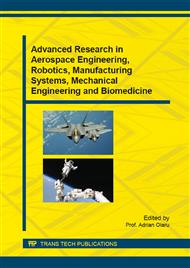p.167
p.172
p.179
p.189
p.194
p.199
p.204
p.210
p.217
Numerical Simulation Method for Velocity Sensors Calibration in High Speed Flows
Abstract:
The paper presents RANS numerical simulations carried out to calibrate the Pitot tube velocity measurements in order to extend the accurate measurement range to high velocities, up to 250 m/s. Three calibration methods are proposed, able to reduce the rms error of the velocity measurement from an initial value of 6.5 m/s, to 3.11 m/s, 2.33 m/s, and 0.08 m/s, respectively. As the accuracy of the calibration method increases, the complexity and the portability of the method for other flows and other Pitot tube dimensions is found to decrease.
Info:
Periodical:
Pages:
194-198
Citation:
Online since:
November 2015
Keywords:
Price:
Сopyright:
© 2015 Trans Tech Publications Ltd. All Rights Reserved
Share:
Citation:


